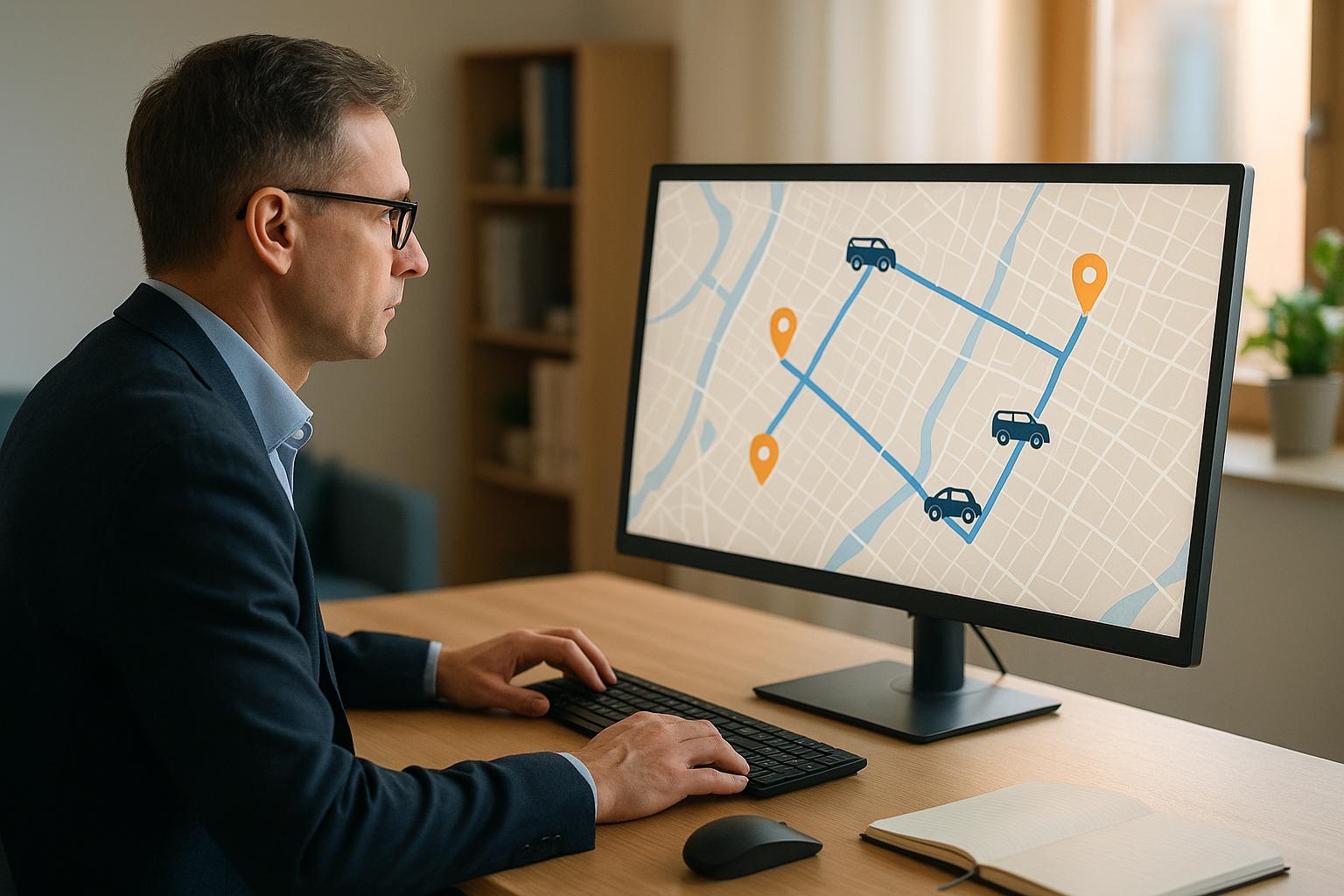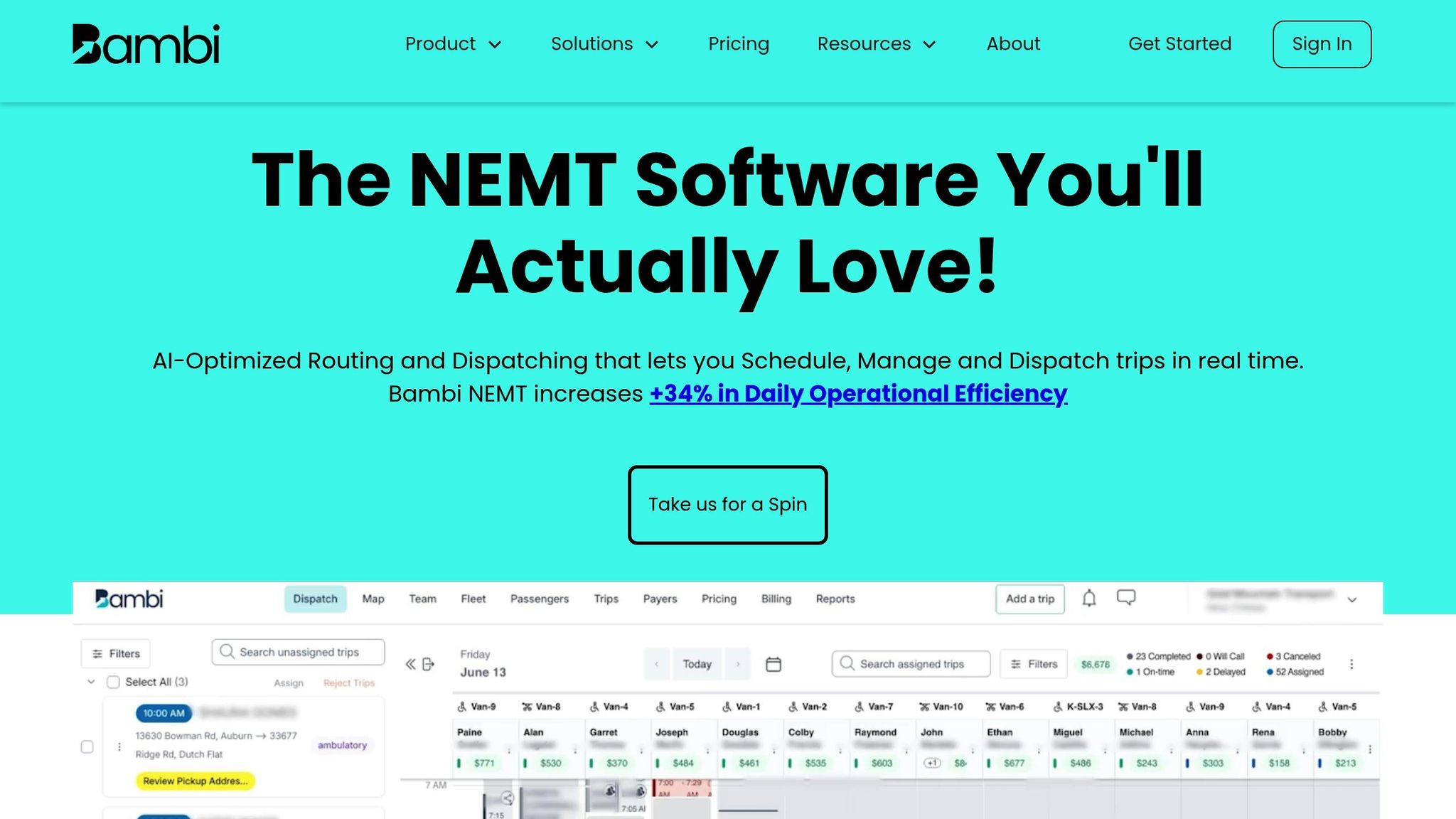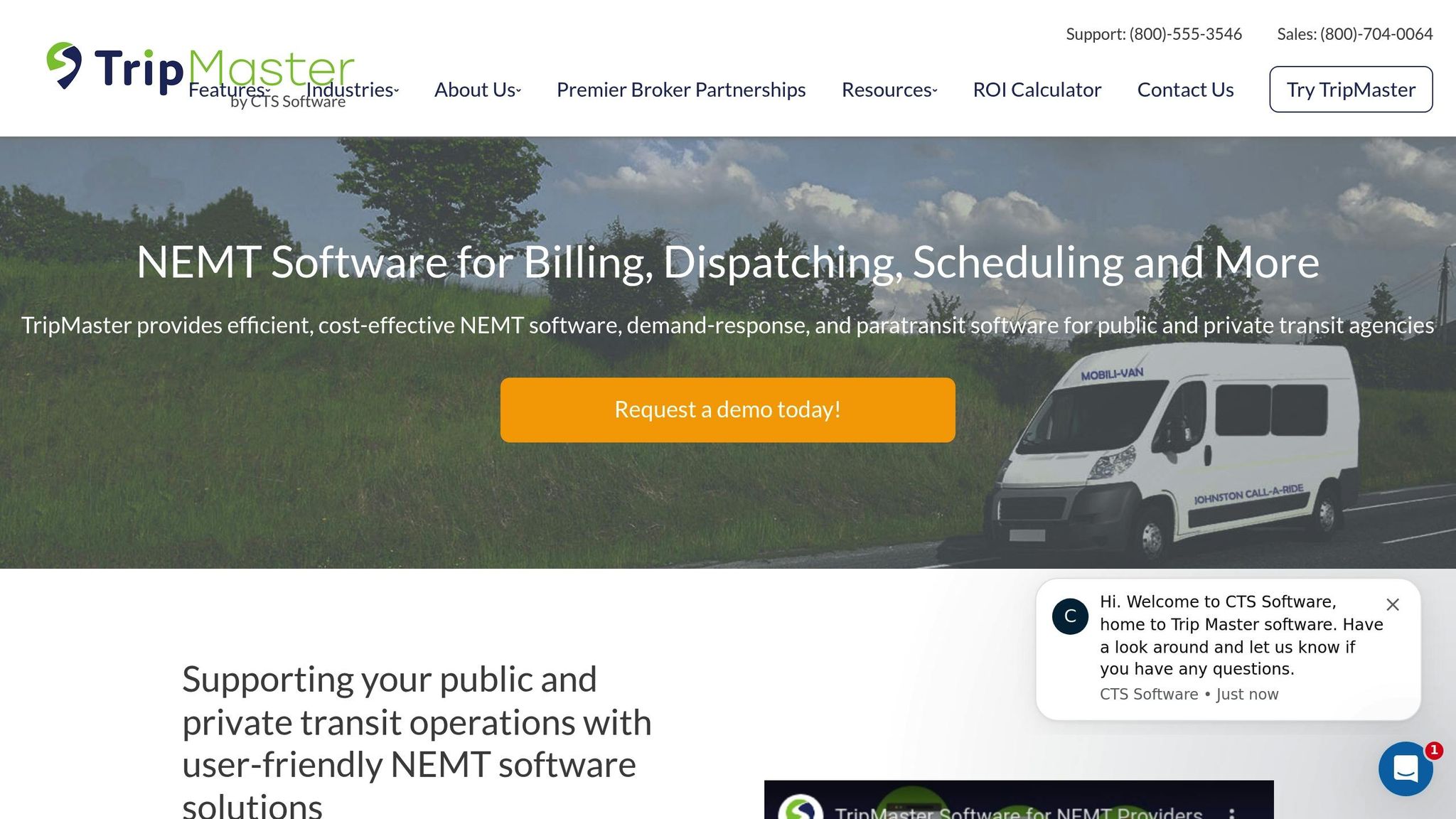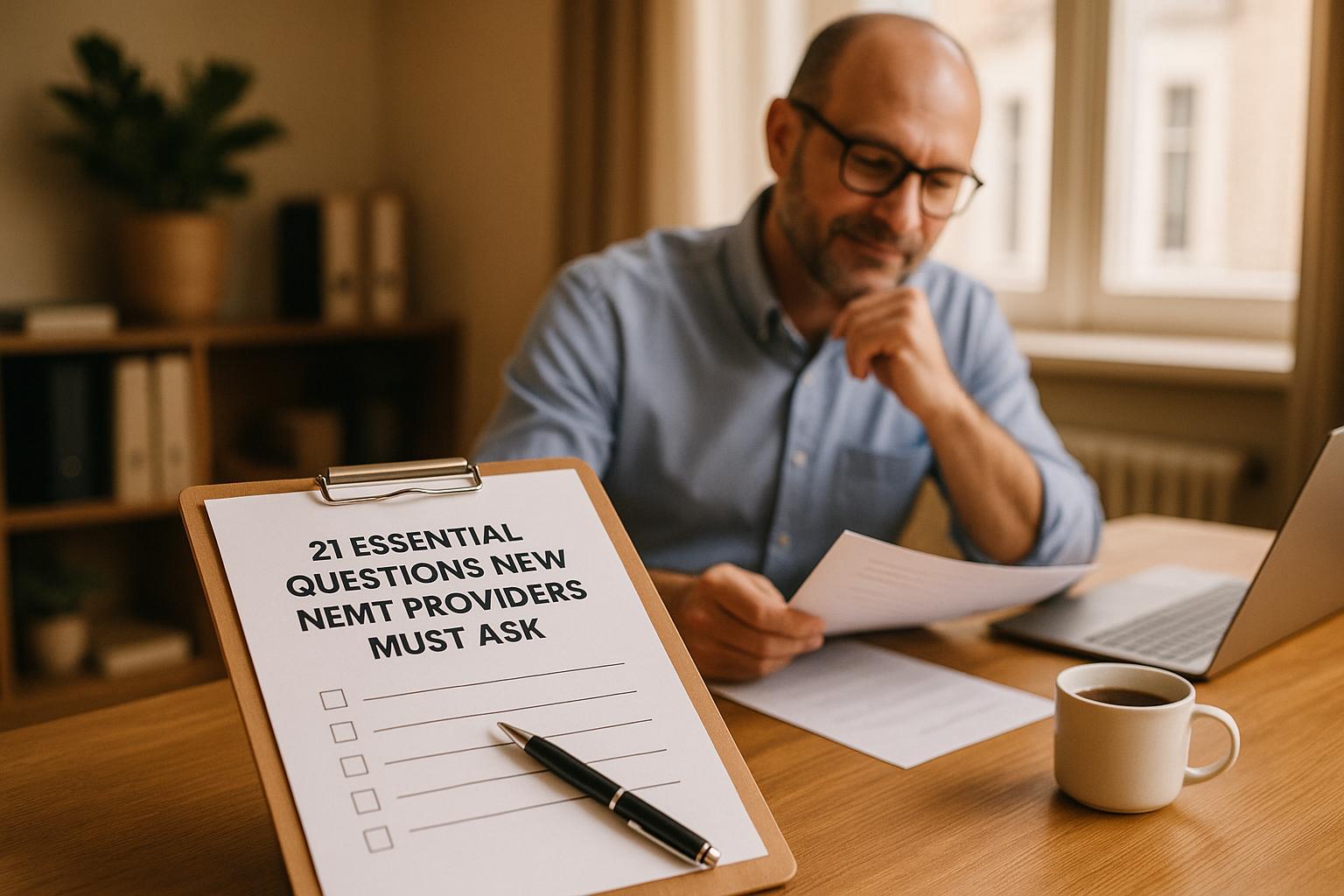.png)
See the full interview on YouTube
Please don't forget to subscribe and like NEMT Experts Podcast on YouTube.
Also, available to watch on Spotify
And listen (audio only) on your other favorite podcast platforms Apple and Pandora.
In this episode of the NEMT Experts Podcast, I sit down with Corey Jones, founder of Royal Care Transportation, to unpack how he built one of the fastest-growing NEMT businesses in his area.Corey went from 0 to 3 vehicles in his first year — and now he’s expanding to 10 vehicles next year. His secret? Smart strategies, private pay contracts, and consistently winning deals with local healthcare facilities.
“It ain’t about what you know, it’s about who you know.”
— Corey Jones, Royal Care Transportation
“People really like to be taken care of — like you’re supposed to be doing.”
— Corey Jones, Royal Care Transportation
“Sometimes you can get greedy. And greed will kill you — it’ll eat you from the inside out.”
— Corey Jones, Royal Care Transportation

Transportation challenges prevent many patients in the U.S. from accessing critical healthcare services. Non-Emergency Medical Transportation (NEMT) providers are bridging this gap by ensuring patients can attend medical appointments, manage chronic conditions, and improve overall health outcomes.
This guide explores how NEMT services have become an integral part of healthcare, from reducing missed appointments to enhancing care coordination. Key takeaways include:
Establish strong healthcare partnerships by setting clear objectives and planning strategically to enhance efficiency and improve patient care.
Start by defining your transportation goals. Are you aiming to reduce inpatient stays, broaden service coverage, or improve patient satisfaction? Each healthcare facility has its own needs, so understanding these is crucial.
For example, hospitals often require round-the-clock discharge transportation to help lower readmission rates. On the other hand, dialysis centers usually operate on predictable schedules, while senior living and rehab facilities need consistent transportation for routine appointments and specialized care. Identifying specific partner needs - like reliable pickups and effective communication - ensures your services align with their expectations.
Mapping out local hospitals, clinics, and specialty care centers can help you identify the best collaboration opportunities. This step lays the groundwork for meeting strict compliance and safety standards.
Healthcare partnerships come with rigorous regulatory and safety expectations. Adhering to federal guidelines, such as HIPAA, is non-negotiable. Implement policies that protect patient privacy and train drivers to handle sensitive information with care.
Vehicle safety is another critical area. Make sure your fleet is equipped to handle wheelchairs, stretchers, and any required medical equipment. Regular inspections and maintenance reinforce your commitment to patient safety.
Building trust with healthcare partners also means conducting thorough background checks and drug screenings for drivers. Maintaining detailed records - such as pickup and drop-off times and any incidents - adds transparency to your operations. With these safety and compliance measures in place, technology can take your service to the next level.
Technology plays a vital role in modern healthcare collaborations, simplifying processes and improving communication. Automated scheduling systems can allow healthcare staff to directly book transportation services, cutting down on administrative work and reducing errors.
Real-time tracking tools provide healthcare facilities with visibility into vehicle locations and expected arrival times. This helps them manage patient schedules more effectively and make adjustments when delays occur. Automated notifications ensure everyone stays informed, enabling timely decisions.
Secure platforms that integrate scheduling and dispatch systems - while maintaining HIPAA compliance - are essential. For instance, Bambi's AI-powered software offers a streamlined solution for managing these operations.
Additional advancements, like electronic health record (EHR) integration and mobile apps with real-time trip updates, give both non-emergency medical transportation (NEMT) providers and healthcare facilities the data they need to make smarter decisions and continuously enhance service quality.
Building strong healthcare partnerships requires understanding decision-makers, fostering meaningful relationships, and making smart use of technology. Below are practical strategies to help you establish and maintain these connections.
Start by identifying key decision-makers - the people who can approve partnerships and understand transportation challenges. These are often transportation coordinators, administrative heads, or facility managers.
Tailor your approach by researching each facility’s unique needs, especially when it comes to transportation and scheduling. This helps you craft a value proposition that resonates.
"Talk to the decision-makers at hospitals and managed care organizations (MCOs)." - Jaycee Morrill, Contributor, Broda
When presenting your services, back your pitch with real-world data. Use testimonials from current partners and fleet performance stats to demonstrate your reliability and compliance with safety standards.
To connect with decision-makers, go beyond emails and phone calls. In-person meetings often make a stronger impact. Many partnership opportunities aren’t listed online, so direct engagement with local hospitals is often the best route.
"Such opportunities are usually not listed online and will require you to physically negotiate with the hospitals in your locality." - Rakesh Patel, Author, Upperinc
Another smart move? Participate in healthcare community events. Industry conferences, health fairs, and local meetings are excellent places to meet potential partners. Joining organizations like the National Association for Healthcare Transportation Management (NAHTM) can also open doors to valuable networking opportunities.
Lastly, specialize in niche services to stand out. Whether it’s dialysis transportation, elderly care, or chronic illness management, focusing on specific patient needs positions you as an expert and strengthens your appeal to healthcare facilities.
These steps create a solid foundation for building strong, lasting partnerships, which brings us to managing those relationships effectively.
Once a partnership is established, maintaining it requires consistent communication and accountability. Regular check-ins and structured feedback systems are essential. Address any issues promptly and share corrective actions to maintain trust and transparency.
Schedule periodic reviews with your partners to evaluate performance, resolve concerns, and discuss opportunities to expand your services. Use simple feedback forms or digital surveys to capture input from healthcare staff, patients, and drivers.
Set clear performance metrics that both you and your partners agree on. Sharing data on on-time performance, patient satisfaction, and response times helps ensure transparency and keeps everyone accountable.
Go beyond the basics by investing in relationship-building activities. Attend hospital staff meetings, participate in patient care conferences, and show genuine interest in your partners’ broader goals. These efforts demonstrate your commitment and build stronger connections.
Finally, maintain detailed records to protect all parties and ease contract renewals. Document everything - from service agreements and performance metrics to incident reports and communication logs. This not only ensures accountability but also simplifies resolving disputes.
Technology can take your partnerships to the next level by streamlining operations and improving communication.
Modern scheduling platforms, real-time tracking, and automated alerts make it easier to manage transportation services. These tools reduce administrative burdens, minimize scheduling errors, and give stakeholders visibility into vehicle locations and arrival times.
For secure operations, use platforms that integrate scheduling and dispatch systems while adhering to HIPAA compliance. For example, Bambi’s AI-powered software combines efficiency with strict data protection, ensuring your operations run smoothly and securely.
Data analytics tools are another game-changer. By analyzing key metrics like pickup times, route efficiency, and patient feedback, both you and your healthcare partners can identify ways to improve services.
Mobile apps also play a big role. They provide patients and their families with real-time updates, reducing anxiety and enhancing the overall transportation experience.
Looking ahead, integrating transportation systems with electronic health records (EHRs) could be a game-changer. Access to relevant patient information - like mobility needs or medical requirements - enables drivers to deliver better care during transport.
Tracking key metrics is essential for fine-tuning service quality and identifying areas for growth.
These metrics provide actionable insights to refine operations and enhance service delivery.
Transform raw data into meaningful insights to improve operations and strengthen relationships with healthcare partners. For example:
Ongoing performance reviews not only streamline operations but also build confidence with healthcare collaborators.
Each partnership model has its own benefits and challenges. Direct contracts foster closer relationships and offer flexibility but often require more administrative effort. Brokered arrangements simplify processes and speed up market entry, though they may limit direct interaction with patients. Many providers find a hybrid model - combining direct contracts with brokered trips - offers a good balance of stability and growth potential.
Regardless of the model, success depends on clear metrics and transparent reporting. These performance insights help address operational challenges and align with collaborative goals.
Even with the best intentions, partnerships in the NEMT sector can run into obstacles that disrupt service delivery and strain relationships. Anticipating these challenges and preparing practical solutions can help providers maintain strong ties with healthcare facilities.
Miscommunication between hospital staff, NEMT providers, and patients often results in delays, missed appointments, and overall poor experiences. Add scheduling challenges to the mix, and things can get even more complicated. For instance, coordinating transportation for patients with specific needs - like wheelchair-accessible vehicles or oxygen equipment - becomes much harder when information doesn’t flow smoothly. On top of that, limited vehicle availability, traffic delays, cancellations, and no-shows can throw route planning into chaos.
The key to tackling these issues lies in improving communication and streamlining scheduling. Start by setting up direct communication channels, like dedicated phone lines or messaging systems, for each healthcare partner. Shared scheduling platforms with real-time updates can also help keep everyone on the same page. Train your dispatch team to gather detailed information during booking - things like patient needs, appointment details, and any special requirements. Automated confirmation systems that remind patients of their scheduled rides can reduce no-show rates, while having contingency plans for common disruptions (like traffic or vehicle breakdowns) ensures quick adjustments can be made when needed.
Once communication and scheduling are under control, the next challenge is navigating regulatory and operational complexities.
NEMT providers must navigate a maze of federal, state, and local regulations. Staying compliant isn’t just about avoiding fines - it’s also crucial for maintaining trust with healthcare partners and ensuring patient safety.
One major hurdle is adhering to HIPAA regulations, especially when dealing with technology systems that handle patient data. It’s not always clear what information can be shared and with whom, and driver training on privacy rules is sometimes overlooked. Beyond HIPAA, providers must also manage vehicle inspections, driver background checks, and insurance requirements, all of which add to the administrative workload. Payment delays can crop up too, especially when payer documentation requirements vary.
To stay ahead, create standardized compliance checklists tailored to each payer and healthcare partner, and update them regularly as regulations evolve. Invest in thorough staff training that covers both the rules and their real-world applications. Partnering with compliance consultants or industry groups can keep you informed about regulatory changes. Technology, like Bambi’s AI-powered software, can simplify compliance checks and reduce paperwork. Building relationships with local regulatory agencies and state transportation departments can also keep you in the loop on upcoming changes. Finally, conducting regular internal audits can help identify and address potential issues before they become bigger problems.
Forming strong partnerships with healthcare facilities is all about combining reliability, smart use of technology, and proactive relationship management. It begins with choosing the right partners - think hospitals, dialysis centers, rehabilitation facilities, and specialty clinics that match your service strengths and geographic reach.
Reliability is non-negotiable. Consistently being on time and maintaining clear communication builds trust, which leads to more referrals. In a competitive market, dependability isn't just a perk - it's what sets you apart.
Technology is your ally. Modern tools can streamline operations and help scale partnerships. Real-time scheduling, HIPAA-compliant systems, and transparent communication channels are essential. For instance, platforms like Bambi's AI-powered software simplify dispatching, scheduling, and compliance for just $69 per vehicle per month, making it easier to meet the expectations of healthcare providers.
Coordination matters. Seamless collaboration with your partners strengthens trust and lays the foundation for long-term growth. This kind of alignment is crucial for building relationships that last.
Compliance is key. Adhering to HIPAA regulations, vehicle safety standards, and payer requirements is vital. Establishing clear processes, providing regular staff training, and keeping detailed records not only protect your business but also enhance trust with healthcare partners.
Ultimately, these efforts go beyond business - they improve patient access to care and contribute to better health outcomes. By starting with one solid partnership, demonstrating your value through consistent performance, and expanding from there, you can grow your network and make a meaningful impact. The rewards? More referrals, stable contracts, and steady business growth.
To ensure HIPAA compliance while leveraging technology to enhance services, NEMT providers need to focus on data security. This can be achieved by utilizing encrypted communication channels, enabling two-factor authentication, and performing regular security audits. Using NEMT-specific software that’s designed to meet HIPAA requirements is another effective way to safeguard patient information and adhere to regulatory standards.
Equally important is providing ongoing staff training on privacy policies and best practices. This helps reduce the risk of data breaches. Periodic compliance reviews are also essential, as they help keep operations aligned with changing regulations, reducing risks and maintaining strong relationships with healthcare partners.
To maintain solid relationships with healthcare facilities, clear and consistent communication plays a crucial role. Regularly scheduled check-ins provide an opportunity to review performance, address any challenges, and ensure everyone is aligned on expectations. This kind of open dialogue helps build trust and encourages collaboration.
Using reliable tools, like real-time tracking systems or automated scheduling platforms, can make coordination smoother and highlight a commitment to professionalism. Beyond that, being dependable, ensuring all credentials are in order, and customizing services to fit the unique needs of each facility are vital steps toward building partnerships that last.
Technology has become a game-changer in improving how NEMT providers and healthcare facilities work together. One standout feature is real-time tracking, which offers a clear view of vehicle locations. This helps cut down on delays, ensuring patients get to their appointments on time. Beyond punctuality, it also strengthens safety measures and keeps communication seamless throughout the journey.
Another key tool is automated scheduling, which takes the hassle out of managing appointments. It lightens the workload for staff, reduces the chances of missed trips, and keeps operations running smoothly. Together, these tools create more efficient and reliable transportation services, helping NEMT providers and healthcare facilities build stronger connections. The result? Better care for patients and more streamlined workflows for everyone involved.

Running a non-emergency medical transport (NEMT) operation comes with a unique set of challenges. Beyond getting patients to appointments safely, you’ve got to navigate a maze of regulations that touch on everything from driver qualifications to vehicle maintenance. Falling short in these areas isn’t just a paperwork issue—it can lead to fines, lawsuits, or even losing your license to operate. That’s where tools like a compliance assessment can make a real difference.
For many providers, staying on top of industry rules feels overwhelming. You need to ensure drivers are properly licensed and trained, vehicles pass rigorous safety checks, and patient information stays secure under strict privacy laws. Then there’s insurance coverage and billing practices, which can trip up even seasoned operators. A thorough evaluation, like our NEMT standards scorecard, helps you pinpoint exactly where your business might be vulnerable. By breaking down these complex requirements into manageable pieces, you gain clarity on what needs attention. This proactive approach not only keeps you aligned with regulations but also builds trust with clients who rely on your services for safe, dependable transport.
Our tool digs into the core aspects of non-emergency medical transport regulations. You’ll answer questions on driver licensing, vehicle safety inspections, insurance coverage, billing practices, patient privacy under HIPAA, and accessibility standards. Each area is weighted based on its importance—licensing, for instance, carries more impact on your score than less critical factors. This gives you a realistic view of where you stand.
We’ve built a smart scoring system that assigns points to each answer based on its significance. Critical areas like proper driver credentials or insurance get higher weight, while secondary factors have a smaller impact. Once you’ve answered everything, we tally up the points, convert it to a percentage, and break it down by category. Anything under 70% in a specific area gets flagged with tailored advice to help you improve.
Absolutely, though it’s not a substitute for legal advice. The NEMT Compliance Scorecard acts like an early warning system, highlighting weak spots in your operations before they turn into bigger issues. By addressing low-scoring areas—like outdated safety checks or incomplete HIPAA training—you can reduce the risk of fines or failed inspections. Think of it as a roadmap to keep your business on the right track.

Route-scheduling integration simplifies Non-Emergency Medical Transportation (NEMT) by combining scheduling and route planning into one automated system. This approach reduces errors, improves efficiency, and ensures compliance with Medicaid and HIPAA regulations. Key benefits include:
Top tools like Bambi, TripMaster, and RouteGenie offer features such as real-time tracking, EHR integration, and billing automation to meet the unique needs of NEMT providers. A phased rollout, staff training, and ongoing analytics ensure successful implementation and continuous improvement.
For providers looking to save time, cut costs, and deliver better service, route-scheduling integration is a practical solution.
When Non-Emergency Medical Transportation (NEMT) providers combine route planning with scheduling systems, they simplify operations, improve service efficiency, and create a better experience for patients. These integrated solutions address common challenges by streamlining workflows and enhancing overall performance.
Blending route planning with scheduling systems can lead to noticeable financial and operational improvements. One major cost driver in NEMT services is "empty miles" - the distance vehicles travel without a patient onboard. An integrated system minimizes these miles by linking trips efficiently, ensuring vehicles are used more effectively. Real-time route optimization also reduces fuel expenses, vehicle wear and tear, and the need for driver overtime.
Delays and traffic are inevitable, but these systems handle adjustments automatically, improving on-time performance without requiring constant dispatcher intervention. This not only saves time but also ensures patients arrive at their appointments as planned.
Additionally, these systems analyze data like usage patterns, peak hours, and popular routes. With these insights, providers can allocate resources more strategically, ensuring vehicles and drivers are available when and where they’re needed most. By streamlining operations and enabling real-time adjustments, providers can save money while maintaining high levels of service.
Manual processes like booking and dispatching are not only time-consuming but also prone to errors. Integrated systems eliminate these bottlenecks by automating trip requests and assigning vehicles based on real-time factors like location and capacity. Dispatchers can monitor vehicle locations through real-time tracking and make quick adjustments when unexpected delays occur.
Drivers benefit from turn-by-turn directions and instant updates via mobile apps, reducing miscommunication and ensuring smooth operations. Meanwhile, automated notifications - such as booking confirmations, appointment reminders, and arrival alerts - keep patients and healthcare facilities informed. This automation frees up staff to focus on more strategic tasks, like improving customer service or planning for growth.
These systems also enhance compliance processes, ensuring that providers meet regulatory standards without adding extra administrative burdens.
Navigating regulatory requirements, especially for Medicaid patients, can be challenging for NEMT providers. Integrated systems simplify the process by automatically recording critical trip details - like pickup and drop-off times, mileage, and service data. This creates a reliable audit trail while reducing the need for manual data entry.
Secure data transmission ensures compliance with HIPAA regulations, as information is encrypted and protected throughout the workflow. By eliminating manual steps like printing trip sheets or transferring data through unsecured channels, providers can maintain stronger data security.
Electronic trip records also minimize errors in billing, which can lead to faster reimbursements and fewer disputes. Automated compliance reports make it easy to prepare for state audits, insurance reviews, or internal evaluations, reducing the workload for administrative teams.
Effective communication plays a key role in ensuring patient satisfaction. Integrated systems provide real-time updates on estimated arrival times, adjusting for traffic and other variables. This replaces outdated static schedules, giving patients more accurate and reliable information.
Proactive notifications keep patients informed every step of the way - whether it’s when a driver is en route, nearing the pickup location, or delayed. This transparency builds trust and reduces anxiety, especially for patients with chronic conditions who rely heavily on dependable transportation.
Dynamic scheduling allows for quick adjustments to appointment changes, with automated notifications keeping everyone in the loop. This flexibility strengthens relationships with both patients and healthcare providers, creating a more reliable and trusted service network.
When it comes to route-scheduling integration, certain features can make or break daily operations. The best systems prioritize smooth communication between platforms and provide real-time updates, ensuring everything runs efficiently and stays compliant with regulations.
APIs (Application Programming Interfaces) act as the backbone of system integration, allowing different software systems to communicate effectively. This connection bridges healthcare providers, transportation services, and various healthcare platforms seamlessly. Without APIs, staff often face the tedious task of manually entering data into multiple systems, which not only slows things down but also increases the likelihood of mistakes.
EHR (Electronic Health Record) integration is another game-changer. It automates trip scheduling based on medical appointments, keeps everyone updated on appointment statuses, aligns transportation with clinical workflows, and even embeds transportation data into patient health records.
Billing platform connectivity takes care of financial processes by automatically transferring trip data to accounting systems. This helps reduce errors and speeds up reimbursement, making the entire process smoother.
Broker portal integration simplifies trip assignments and updates by connecting directly with brokers. This reduces the manual workload and keeps things moving efficiently.
Cloud-based platforms and SaaS solutions make real-time data sharing possible across all stakeholders, including drivers, dispatchers, healthcare providers, and payers. For example, if an appointment gets rescheduled, everyone involved is updated instantly, ensuring nothing falls through the cracks.
These features not only improve daily workflows but also support compliance and make reporting easier.
In a fully digitized healthcare environment, automated billing processes help reduce rejected claims and unpaid bills. This streamlining of financial operations ensures that providers can focus on delivering quality care without being bogged down by administrative hurdles.
To achieve the operational efficiency and compliance improvements outlined earlier, a well-structured implementation plan is essential. Successfully integrating route-scheduling software involves careful planning, phased execution, and minimizing disruptions to daily operations.
Start with a thorough operational and technology assessment. This means evaluating your current processes across all locations, documenting workflows, identifying problem areas, and reviewing your existing technology setup. You'll also need to assess staff skills, training needs, and compliance requirements while establishing performance benchmarks for future comparisons.
Gather input from stakeholders, considering operational needs, budgets, ROI, and timelines. This helps pinpoint specific challenges unique to each location and ensures the new system integrates seamlessly with your current infrastructure.
Create a detailed vendor selection process. This involves drafting comprehensive RFPs, conducting product demos with shortlisted vendors, checking references, and performing a total cost of ownership analysis. Taking these steps early can help you avoid expensive mistakes down the road.
Pilot the system at one stable location first. Testing the software in a real-world environment allows you to validate its functionality and identify integration issues early. Use this phase to develop training materials, refine processes, and establish best practices that can be applied to other locations.
Roll out the system gradually. Expand implementation to additional locations systematically, using lessons learned from the pilot phase. Standardize training programs, document procedures, and establish clear technical support and change management strategies.
"Consider rolling out the new software in phases rather than switching everything at once. This reduces the risk of widespread disruption if any issues arise."
– NEMT Cloud Dispatch
Simulate real-world scenarios and test data migration repeatedly. If data migration is required, run multiple tests to ensure accuracy and security during the transfer process.
Once the system is in place, the next step is equipping your team to use it effectively.
Tailor training programs to specific roles. Dispatchers and drivers have different responsibilities, so focus on role-specific, hands-on training in a controlled environment. This allows staff to practice without impacting day-to-day operations.
Implement ongoing training initiatives. Training shouldn't stop after the initial rollout. Plan regular sessions to cover new software features, share best practices, and provide performance coaching based on system analytics. Cross-training employees can also increase operational flexibility.
Keep employees informed about upcoming changes and benefits. Regular updates help create transparency, while a feedback loop allows staff to raise concerns and ask questions, reducing resistance to change.
Proactively address resistance by involving staff in the process. Employees are more likely to embrace the new system if they feel their input is valued. Identify champions within each department to encourage their peers to adopt the changes.
Once training is complete, focus shifts to continuous improvement and system optimization.
Set up processes for ongoing optimization. Regular performance reviews, continuous training, and technology updates help ensure the system evolves alongside your operations. Use data insights and stakeholder feedback to refine workflows and address inefficiencies.
Leverage system analytics to make data-driven decisions. Analyze route performance, driver efficiency, and patient satisfaction to identify areas for improvement. Track compliance metrics to ensure regulatory standards are being met.
Monitor performance and gather staff feedback regularly. This enables you to quickly identify and resolve issues while making necessary adjustments to improve processes.
Centralize data tracking with dashboards. Unified dashboards make it easier to monitor performance across locations. Optimize routing algorithms for regional conditions, establish standardized reporting, and fine-tune user permissions and workflows.
Enhance system functionality through integrations. Connect the software with healthcare management, accounting, and HR systems for a more streamlined operation. Mobile apps can also improve communication between drivers, dispatchers, and patients, ensuring smoother coordination.
Choosing the right route-scheduling integration tool can make a big difference in how smoothly your NEMT (Non-Emergency Medical Transportation) operations run. The ideal software should handle scheduling, route optimization, real-time tracking, and dispatching while meeting healthcare regulations like HIPAA and Medicaid requirements. Below are some standout platforms designed to simplify scheduling, routing, and compliance for a variety of NEMT needs.

Bambi is an AI-powered platform designed specifically for NEMT providers. It covers dispatch, scheduling, compliance, and real-time communication, all while addressing U.S. regulatory requirements. Priced at $69 per vehicle per month, it aims to streamline daily operations through advanced automation.
Bambi also supports data analysis, billing, and audit preparation - key features for providers managing complex billing across multiple payers. Its strong integration capabilities allow it to connect easily with Electronic Health Records (EHR), fleet management systems, and broker portals like MTM, ModivCare, and LogistiCare. The platform’s user-friendly interface syncs with mobile apps for both dispatchers and drivers.
For businesses that are expanding, Bambi offers scalability and customization to help cut down on travel time, fuel costs, and manual tasks, while ensuring better use of resources.

TripMaster is tailored for NEMT operations that handle high trip volumes and work with multiple brokers. It specializes in multi-load routing and broker portal integration. The software offers a "pay-as-you-go" pricing model, making it a flexible choice for startups. Pricing details are available upon request.
TripMaster includes tools to ensure compliance with regulatory standards and excels in optimizing complex routing scenarios involving multiple passengers. It simplifies broker coordination, managing intricate data exchanges to maintain accurate records, billing, and fleet efficiency.
RouteGenie is a great fit for providers working with multiple brokers. Starting at $50 per vehicle per month with no setup fees, it focuses on streamlining multi-broker operations. The platform allows providers to manage trips from various sources while keeping billing and reporting separate for each broker.
RouteGenie automates the process of importing trip data directly from broker systems, reducing administrative tasks and minimizing billing errors. Its route optimization algorithms handle diverse broker requirements, such as varying pickup times, vehicle types, and patient needs, making it ideal for complex multi-broker setups.
Each of these tools has unique strengths, and the best choice will depend on your operational needs, broker relationships, and growth plans. Whether you prioritize AI-powered dispatching, multi-load optimization, or seamless broker integration, make sure to evaluate pricing details, including what’s included in training, support, and maintenance, to get a clear picture of the total cost.
For more industry insights, visit NEMT Entrepreneur at https://hibambi.com.
Integrated route planning and scheduling can reshape how Non-Emergency Medical Transportation (NEMT) providers operate, simplifying workflows while improving the quality of service. By fine-tuning routes, ensuring regulatory compliance, and enhancing communication with patients, this approach helps providers cut costs and improve overall efficiency.
Key elements like dynamic route optimization, seamless system integration, and strong compliance tools tackle the unique challenges NEMT providers face. When combined, these features form a powerful solution tailored to the complexities of NEMT operations.
Implementing these systems successfully requires a careful strategy. A phased approach that includes pilot testing, focused staff training, and ongoing, data-driven adjustments ensures a smooth transition. This method works hand-in-hand with the advanced tools discussed earlier, paving the way for more efficient operations.
The good news? There are plenty of tools available to suit providers of all sizes. Whether you're managing a large-scale operation or catering to specific patient groups, there's a system designed to meet your needs.
As the NEMT industry continues to demand greater efficiency, tighter compliance, and more patient-focused care, adopting integrated route planning and scheduling puts providers in a strong position to thrive. The technology is available, the benefits are clear, and now is the time to make the shift.
For more expert tips on combining route planning with scheduling, check out NEMT Entrepreneur.
Integrating route planning with scheduling systems allows NEMT providers to stay compliant with Medicaid and HIPAA regulations by ensuring secure and precise data handling. These systems incorporate HIPAA-compliant tools such as encryption, access controls, and detailed audit trails, safeguarding patient information while meeting strict regulatory requirements.
This integration also simplifies Medicaid billing and reporting by ensuring accurate documentation for audits, reducing errors, and avoiding non-compliance issues. By protecting sensitive data and minimizing legal risks, providers can concentrate on offering reliable and efficient transportation services.
When choosing a route-scheduling integration tool for your NEMT business, it's essential to focus on features that can boost both efficiency and service quality. Key functionalities to look for include real-time traffic updates, automated dispatching, GPS tracking, and route optimization algorithms. These tools can help streamline your operations, minimize delays, and ensure smoother trips.
Equally important are the system's ease of use, its ability to scale with your business, and how well it integrates with your current platforms. Make sure the tool also supports compliance tracking and provides dependable customer support to resolve issues promptly. By keeping these factors in mind, you can select a solution that improves trip coordination, driver management, and overall customer satisfaction.
To transition smoothly to a new route-scheduling system, it’s wise to take a phased approach. Start by rolling out basic automated scheduling tools, allowing your team to get accustomed to them before gradually adding more advanced features. This step-by-step method helps prevent your team from feeling overwhelmed.
Involve your staff early on by including them in training sessions and decision-making processes. This not only encourages buy-in but also ensures they feel comfortable and confident with the system. Clear communication about what’s changing - and why - can go a long way in reducing any pushback.
Make sure to offer ongoing support and keep a close eye on performance metrics. This will help you quickly spot and resolve any issues that arise. With a well-thought-out rollout plan and regular feedback, you can ensure the transition is both smooth and effective.

Running a non-emergency medical transport (NEMT) business comes with unique challenges, especially when it comes to training drivers. Ensuring they’re equipped with the right skills for safe vehicle operation, proper patient care, and adherence to regulations is no small task. That’s where a tailored driver training checklist becomes invaluable. It’s not just a piece of paper—it’s a roadmap to consistency and quality in your operations.
Every NEMT company has its own set of priorities, from specific safety protocols to unique ways of handling emergencies. A generic training guide often falls short, leaving gaps that could impact service or compliance. By using a tool to generate a personalized checklist, you can address every detail that matters to your team. Think of it as a way to build confidence in your drivers while protecting your business from oversight.
Beyond meeting legal standards, a well-structured training plan boosts driver performance and patient satisfaction. When drivers know exactly what’s expected—whether it’s securing a wheelchair or responding to a medical concern—they’re better prepared to handle real-world scenarios. Investing in a custom solution for training documentation can save hours of manual work, letting you focus on growing your NEMT service with peace of mind.
Absolutely! Our NEMT Driver Training Checklist Generator is built for customization. There’s a dedicated section where you can add any unique policies or procedures that apply to your business. Whether it’s a specific way to handle paperwork or a particular protocol for driver conduct, just type it in, and it’ll be categorized appropriately in the final checklist.
Yes, it’s designed with compliance in mind. You can input requirements related to local or federal regulations for non-emergency medical transport, and the tool will organize them under a compliance category. That said, I’d recommend double-checking the final list against your specific regulatory standards to ensure nothing’s missed—regulations can vary widely by region.
Once you’ve generated the checklist, it’s super easy to download or print directly from the tool. You’ll get a clean, professional-looking document with your company name and a date field if you’ve added those. Save it as a PDF for digital records or print copies for your drivers to keep on hand during training sessions.

markdown:
Running a non-emergency medical transport (NEMT) operation comes with unique challenges. Between coordinating drivers, scheduling patient pickups, and ensuring vehicles are road-ready, it’s easy to feel overwhelmed. That’s where a dedicated tool for organizing your fleet can make a world of difference. A solution designed for NEMT businesses helps you map out trips, assign drivers, and stay on top of vehicle upkeep without the usual stress.
When you’re managing multiple vehicles, every detail counts. A single scheduling mix-up can delay critical appointments, frustrate clients, and hurt your reputation. By using a planner tailored for NEMT operations, you get a clear visual of your daily and monthly commitments. It flags overlapping trips or driver assignments, so you can fix issues before they spiral. Plus, tracking maintenance ensures your vehicles are always in top shape for those who depend on your service. If you’ve been struggling to keep everything in order, this kind of tool might just be the game-changer your business needs to thrive.
Our NEMT Fleet Management Planner automatically scans for overlaps in trip schedules for each vehicle or driver. If a vehicle is booked for two trips at the same time, or if a driver is double-assigned, it flags those issues with a bright alert on the calendar. You’ll see exactly where the problem is, so you can reshuffle assignments before it becomes a headache. It’s all about catching those little hiccups before they turn into big delays for your clients.
Absolutely! You can input maintenance dates and the type of service—like oil changes or tire rotations—right into the tool. It’ll highlight upcoming maintenance on the calendar view, so you’re never caught off guard by a vehicle being out of service. This way, you can plan around those dates and keep your fleet running smoothly for your non-emergency medical transport clients.
Yes, it’s super simple. With just a click, you can toggle between a weekly breakdown to focus on the day-to-day, or a monthly overview to see the bigger picture of your fleet’s commitments. Both views show driver assignments, trip details, and any alerts for conflicts or maintenance, so you’ve got all the info you need no matter how you prefer to plan.

We are absolutely thrilled to announce that Bambi has been recognized as the winner of the Innovation in NEMT award at the 2025 NEMTAC Industry Awards! This is a monumental achievement for our team and a testament to the groundbreaking work we’re doing to revolutionize non-emergency medical transportation.
This prestigious honor, awarded to only one company each year by the Non-Emergency Medical Transportation Accreditation Commission (NEMTAC), celebrates the pioneering contributions and ingenuity that are truly transforming the industry. To be selected from a competitive field of industry leaders is an incredible validation of our mission.
The Innovation in NEMT award is more than just a trophy on the shelf. It’s a recognition of the real-world impact our software is making. The award celebrates creative problem-solving and cutting-edge technology that drives measurable improvements for NEMT providers and the patients they serve.
We were recognized for how Bambi’s AI-powered software enhances operational efficiency, improves patient outcomes, and sets a new standard for excellence in medical transportation.
Our CEO and Co-Founder, Nirav Chheda, put it best: "Receiving this recognition from NEMTAC is an incredible honor that validates our team's unwavering commitment to simplifying NEMT. This award reflects our dedication to developing solutions that don't just meet current industry needs, but anticipate and solve tomorrow's challenges in NEMT."
At the heart of this win is our cutting-edge approach to NEMT. Bambi’s software leverages artificial intelligence to give NEMT owners, dispatchers, and drivers superpowers. We empower them to dynamically assign, optimize, and manage their daily trips and workflows, leading to measurable improvements in scheduling, dispatch and routing.
This isn’t just about technology for technology's sake. It's about ensuring riders get to their crucial medical appointments safely and on time. It's about making life easier for the heroes on the ground who manage the complex logistics of NEMT every single day.
"This award belongs to our entire team, whose creativity and technical expertise continue to push the boundaries of what's possible in NEMT technology," added Charles Henick, our CTO and Co-Founder. "We're proud to contribute to an industry that plays such a vital role in connecting patients with the care they need."
The award was presented at the 2025 NEMTAC Transform conference, an amazing event that brings together the brightest minds in our industry. We were inspired to be surrounded by fellow professionals, technology leaders, and healthcare advocates all dedicated to moving NEMT forward.
We are incredibly proud of this achievement and even more excited for the future. Thank you to NEMTAC for this incredible honor, and to our partners and clients for trusting us to be their technology solution. We’re just getting started!
Ready to see how Bambi’s award-winning software can transform your NEMT operations? Learn more about Bambi today!

Running a non-emergency medical transportation (NEMT) business comes with a unique set of financial challenges. From fuel for your fleet to driver wages and vehicle upkeep, the expenses can stack up fast. That’s where a reliable cost estimation tool becomes invaluable. It helps owners map out their monthly outlays with precision, ensuring they’re not caught off guard by hidden fees or overlooked categories.
For those in the medical transport niche, every dollar counts. You’re not just moving people—you’re providing a critical service that demands reliability. Keeping tabs on operational expenses like insurance per vehicle or maintenance schedules can mean the difference between profit and loss. A tailored calculator designed for this industry takes the guesswork out of the equation, letting you input real data for a clear financial picture.
Whether you’re a seasoned operator or launching your first van, understanding your budget is key to growth. Tools that break down costs into digestible chunks empower you to make informed decisions. So, dive into the numbers, tweak your strategy, and steer your business toward success with confidence.
Our tool covers all the big hitters for a non-emergency medical transport business. You can calculate monthly fuel expenses based on miles driven and gas prices, driver wages by inputting hours and rates, plus insurance and maintenance costs per vehicle. It even lets you toss in miscellaneous expenses like office supplies or permits. Basically, it’s a full picture of what you’re spending each month to keep your operation rolling.
We’ve built this tool to be as precise as possible, rounding all results to two decimal places for clarity. Fuel costs assume a default 15 MPG if you don’t specify otherwise, and everything else—like driver pay or insurance—is based purely on what you input. Of course, real-world costs can vary with unexpected repairs or price hikes, but this gives you a solid baseline to work from. Play around with the numbers to see different scenarios!
Absolutely, and honestly, it’s a great time to start using it. If you’re in the planning phase, you can input estimated figures for vehicles, miles, or wages to get a sense of what your monthly costs might look like. It’s a handy way to test different setups before you commit. Once you’re up and running, just update the data with real numbers to keep your budget tight.

Entering the Non-Emergency Medical Transportation (NEMT) industry can feel like stepping into uncharted territory. For aspiring entrepreneurs and professionals in the field, navigating the complexities of compliance, pricing, licensing, and operations may seem overwhelming. Unfortunately, as the video suggests, gatekeeping is rampant in the NEMT sector, with many experienced providers reluctant to share critical insights.
To help break through these barriers, this article distills the key takeaways from the video "21 Essential Questions New NEMT Providers Must Ask." This comprehensive guide will unravel the vital questions every new NEMT provider must ask to establish a successful business, backed by actionable advice and insights.
Starting an NEMT business goes beyond acquiring a vehicle and obtaining licenses. It's a multidimensional process involving market research, financial planning, compliance, and operational management. Asking the right questions upfront not only saves time and money but positions you for long-term success in a competitive industry.
This article organizes these vital questions into logical categories to ensure you have a clear roadmap for your journey as a new NEMT provider.
Starting an NEMT business requires careful budgeting. Essential expenses include:
The video emphasizes the importance of determining the minimum viable budget to avoid overextending financially.
To be operational, your vehicle must meet compliance standards. On average:
Profitability depends on multiple factors like fuel costs, driver wages, and dispatching fees. For instance:
Pricing depends on your target clientele:
In many states, you can start with your personal vehicle as long as it is registered under your business name. This option can minimize startup costs, but compliance varies by state and broker requirements.
Your business structure affects liability and taxation. While LLCs are a popular choice for small businesses, consulting a CPA for personalized advice is highly recommended.
Compliance requirements differ by state but often include the following:
Costs vary depending on the format (online or in-person):
Typically, becoming a Medicaid provider takes 2–4 weeks. However, processing times vary by state. Completing the necessary applications and certifications promptly is crucial.
Some states, like North Carolina, charge application fees (e.g., $100). Others do not. Research your state’s requirements to avoid surprises.
Reaching brokers requires persistence. Strategies include:
Brokers often assess:
Red flags include:
Timelines vary based on your outreach efforts. Building relationships with medical facilities, attending industry events, and leveraging social media can expedite the process.
Yes, you can focus exclusively on private pay. This approach often results in higher profit margins but requires strong networking and marketing efforts.
Popular options include:
A day might include early starts for medical appointments, afternoon dispatching activities, and end-of-day administrative tasks. The unpredictability of trips adds variety but demands strong organizational skills.
The video highlights a lack of education about broker relationships and the inability to negotiate rates as common pitfalls. Proactively learning these aspects can save you time and money.
Prioritize essential certifications (PASS and CPR), insurance, and use an existing personal vehicle to minimize initial expenses.
Success in NEMT hinges on asking the right questions and taking a proactive approach to preparation and problem-solving. From startup costs to broker relationships and operational tools, these 21 essential questions form the foundation for building a thriving NEMT business. By breaking through the gatekeeping culture and embracing a mindset of learning and persistence, you can position yourself as a formidable player in this growing industry.
Armed with this knowledge, take the first step toward becoming not just a participant but a leader in the NEMT sector. Your journey starts with the right questions - and now, you have the answers.
Source: "THE GATEKEEPERS|| 21 Questions every NEW NEMT PROVIDER should RESEARCH | Nemt University" - Nemt University, YouTube, Aug 6, 2025 - https://www.youtube.com/watch?v=wPjyIQLr7-I
Use: Embedded for reference. Brief quotes used for commentary/review.